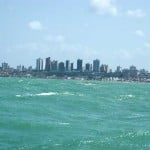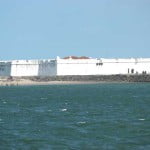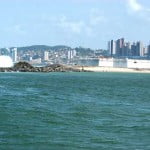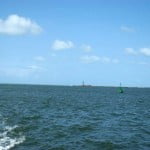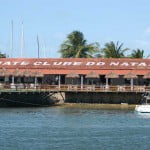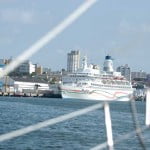Sunday, 11-09-05
We arrived yesterday at daybreak for one more shooting session. It’s been hectic for the past weeks. We had barely gotten to São Paulo when we locked ourselves up at the production studio to edit the material that had collected. Right after getting things done, it was already time for another trip. With such a routine, we end up having little time for any preliminary research before setting up for a new journey, which is a pity, because we waste time whenever arriving at a new site, as in Rio Grande do Norte now. Another setback we come up against is the fact that shoring up here in the northeast is pretty rough at this time of the year. There are very strong winds all the time, bars which are silted up and not demarcated on the navigation chart, besides several dangerous reefs. This is why we haven’t been anchoring near the bars since we left Fortaleza. Instead, we have anchored at the major harbors and covered the shore by car, as now in Natal.
Even so, we went on a boat trip early today to check out Natal’s shore seen from the sea, to shoot some pictures and do some filming. We were stunned by the size of the waves we saw right off the bar. After half a mile off the mole, we were hit by some three-meter waves on the bow. We had sailed for around one hour, long enough to do the shootings, and were already back to the quiet on the Potengi river, where we anchored in front of Natal’s Yatch Club.
The problems concerning land settling on the northeastern coast are quite similar, except for each state’s specificities. Here, as well as in Ceará, the biggest issues are shrimp cultivating crustacean culture and the great real estate lobby resulting from tourism expansion.
On top of that, Rio Grande do Norte produces 90% of the salt used in Brazil. Despite being an old, traditional activity, extraction is also harmful to the environment. It follows a similar process to the way shrimp is obtained: since swamps are easier to deal with, and are nearer the sea, they are made into pools where salt water is dammed, and then evaporated by the strong heat, the winds and the lack or rain.
That’s when the period of withdrawal and processing of salt starts. These areas are usually in the north of the state, right before the Ceará border, in Mossoró and in Macau, and at the “Areia Branca” harbor. They take up approximately 20 thousand hectares of marine land in estuary zones. We plan to stop by for a closer look at the area. Petrobrás extracts oil in the same region, both in coast and sea wells.
In the conversations we’ve had with environmentalists, public prosecutors and professors from the Rio Grande do Norte Federal University, we heard of no reports so far on the supposed damage that has been brought about.
As to tourism, one hears the same claims as in Ceará. The Italians were the first to get here about fifteen years ago. About five years ago came the Norwegian and the Swedish, followed by the Portuguese and the Spaniards. They are buying whatever they can, building hotels, “pousadas” and resorts. According to prosecutor Marcio Luis Diógenes, the Portuguese are the ones who invest the most money here, usually by buying preservation areas – the APPs (protected areas).
As Diogénes reported, state administration fosters tourism because of the revenues it brings, but it ignores the environmental issues.
Monday, 12 – 09 – 05
This morning we talked to the person in charge of the ecology department at the federal university, Aristotelino Monteiro Ferreira. He considers crustacean culture to be the major environmental problem in this state. That figures, since Rio Grande do Norte is today the biggest shrimp producer in the country.
He told us about his battle with the City Hall Department because of the degradation of the swamps on the Potengi river estuary, which are already affected by their proximity with the capital city. Only 20% of their sewers are treated, and the fact that they give access to Natal’s harbor makes them vulnerable to all types of problems caused by the flux of ships.
The swamps on the Potengi river have been taken over by several shrimp traders, who work on a co-op basis. They’ve adopted the name “Fazenda do Povo” (= Farm of the People) and cleared around 100 hectares. According to one of the professors, things slowed down after the farm was inspected some time ago, although farming activities went back to normal after the initial hubbub.
Here in Natal many entrepreneurs sponsor small farmers because it is an easy way for them not to expose themselves. When the fishing is over, they purchase the products, export them, and pocket the profits. The entrepreneurs, in fact, wind up using the small farmers. Whenever there is any inspection going on, they play smart and claim that, in case of embargo, the “poor fellows” will lose investments, etc. Therefore, nothing is done against them. One hasn’t heard of any fines being issued, there’s no inspection anywhere, and farms here, just like the ones in Ceará, do not have Eia-Rima ,
Later on that day we spoke to prosecutor Diógenes, who told us, to our surprise, that this area was being invaded by the state’s own farming and cattle-raising company in a joint program with a private local university , “carrying out a commercial activity of scientific nature”. The degradation was made evident by a report, and a lawsuit ensued. It was deemed valid. The farmers appealed to a higher court, there was a judicial appeal, but the court acknowledged the lawsuit. The case is now at the Supreme Court, and only God knows when it will go on trial.
The same prosecutor informed us about lawsuits he has filed against the state and the City Hall, who throw the sewer remains from Natal in the Potengi river. His aim was to accuse public authorities of omission, since public health is the citizen’s right, but he was barred because the judiciary power was unable to intervene in public policies, which were supposed to be under the legislative department. Indeed, it sure isn’t easy to get things changed. Tomorrow we’ll be traveling over the south coast. We’ll go all the way down the Cunhaú river bar to check out the crustacean culture and the real estate projects in the area. From what we’ve been told, things have been rough over there.
Tuesday,13-09-05
We left early in the morning towards “Praia da Pipa”, which is around 80 km away from Cunhaú river’s bar, in the southern area of Natal.
I was pleasantly surprised on the way along the shore. You can still come across great areas of atlantic forest, especially on the dunes.
Most of Natal’s southern shore has small and large Atlantic forest “islands”. They cause the sand to settle on the dunes by blocking the winds. These are relatively small areas which should be preserved. However, they’re slowly being taken up by the constructions that hoard over them. Of the ten beaches we were on, I didn’t see one single beach which was not packed with condominiums, houses, apartment buildings and hotels. The famous Pipa beach is the biggest example.
Within very little space, squeezed by sea cliffs and a promontory, where there used to be a fishermen’s village, a little town has popped up in the past ten years, with dozens of “pousadas”, restaurants , small stores, etc. The very narrow streets become even narrower with the great number of vehicles that use them, from cars to tour buses, buggies, motorcycles, you name it. It’s a chaotic place, a type of high middle class slum. I was appalled by how much bigger this small town has become. There’s no more room for any construction on the shore, so new ones are spreading over the hills, crushing the vegetation which, for so long, has kept the mountain intact. Due to the clearing of the vegetation, there will soon be land-sliding and erosion. Only a caricature was left from the old fishermen’s village.
From the Pipa beach we went to “Barra de Cunhaú”, a village on the Cunhaú river shore to visit the shrimp farms that were settled there about ten years ago, and which have made Rio Grande do Norte the biggest shrimp producer in Brazil. You don’t have to go very far to witness the damage. Huge areas, all of which are swamps in permanent reserves, have been devastated to make room for shrimp tanks.
It’s sad to realize that people remain unpunished for this type of crime; many times they are even covered up by the government, despite professors and environmentalists’ alertness. This is one more estuary of the seven owned by the state, already extremely polluted mostly by the lack of garbage collecting and basic sanitation systems, but also by agricultural and industrial pollution. According to professor Aristotelino, “all the estuaries in Rio Grande do Norte have reached their maximum capacity from the point of view of pollution. And now, to make things worse, the coast has been taken over by the crustacean culture, an economic activity that pollutes waters in general. We did some filming and shooting, as usual, and once we were finished, we headed back to Natal. We spent the night at a pousada on Buzios beach. The next day, we were going to film the beaches on Rio Grande do Norte’s south shore.
Wednesday, 14 – 09- 05
By 8:30 a.m. we were all set to get in the jeep for the tour. Just as in Ceará, the beaches here are the tourists’ favorite routes, even though
some nest the turtles’ egg-laying. I didn’t feel comfortable using the beaches as a road, but I’d have sounded demagogic if I had asked the driver to take another route, since we intended, precisely, to check how the coast is being used to make a report about its occupation. Once again, I didn’t like what I saw. Rio Grande do Norte is one more state holding no ecological economic zoning plan, so it looks as if people have built wherever and whatever way they pleased.
Houses are set apart by green walls made with pine trees. I had seen those green walls on the east coast of Ceará, but there are many more of them here.
It’s absurd to see this type of non-tropical tree, typical of mountainous countries, on the Brazilian coast. And that’s not all. You can also see houses built on top of the dunes here. There are still quite few buildings because there are not enough people visiting the coast, but I wonder how long that will last. Whenever there is an economic burst in Brazil, and prices of airplane tickets drop, domestic tourism will boom,
which means buildings will pop up all over, since there are no legal constraints.
There are also few resorts here and there. However, public administration is in favor of tourism expansion, so it won’t take long to start seeing a lot more resorts around here.
As said the prosecutor who we spoke to: “ the government stirs up tourism, but it is not concerned about the environment”. Government officials do their best to attract investors, who in turn are not presented with clear occupation policies as soon as they set foot here. Officials don’t realize that low-profile tourism might benefit this area as much as traditional tourism does. It will not be killing the hen that lays the golden eggs, which is what traditional tourism does, harming the environment dramatically, many times causing irreversible changes to the landscape.
Buzios is a village which spreads out from the shore along most of the coastal area. It reaches as far as 300 km inland all the way upon the dunes. As a matter of fact, most of the coast in Rio Grande do Norte is formed by dunes or sea cliffs. Even Natal looks like it was built on great dunes. The ones in Buzios are coated with Atlantic forest vegetation, with lots of lagoons on top, always surrounded by dense vegetation on the margins.
On the whole, the south coast in Rio Grande do Norte is almost 100% taken. Tomorrow we shall be going north, towards the salinas region in Mossoró.
Thursday, 15 – 09 – 05
We spent the whole day inside the car, driving almost all the way up the Ceará border. We stopped in Agua Branca for a while to see the “Porto Ilha”, an inventive construction of an off-shore port.
This is a very shallow area, so at one point ships couldn’t get in to fill up at the dock. They had to anchor away from the dock, and wait for the barges to unload the salt by tying up counter board and finally loading the cargo after great difficulty.
To solve that problem, a huge structure was built 14 km off the shore, and on top of it a 100-meter long by 100-meter wide platform was set up, making room for a completely furnished dormitory, a salt warehouse, cranes and rolling mats which load the products more quickly and at lower cost. They have a 200thousand ton monthly turnover, of which 40% is geared to the foreign market, and 60% distributed all over Brazil.
Rio Grande do Norte holds 90% of Brazil’s salt production. This entire area, including Mossoró and Macau, stands as the biggest producer. Besides the production drained through the sea, another 120 thousand-ton monthly load is shipped inland via trucks. As soon as we arrived, we looked for the person in charge of the port and arranged to go visit him tomorrow on our motor boat.
Friday, 16 – 09 – 05
“Porto Ilha”, the off-shore port built in the sea, is amazing. It has a huge structure made of steel, anchored over gigantic concrete stakes
stuck in the bottom of the sea, with rolling wakes all over, cranes, and mostly heavy-duty machines. An average of thirty people run the scheme. We got there early, together with the maintenance team and the harbor pilot, who set off to fetch a ship. We watched all the maneuvering and tie up steps. It is a risky, complex operation in which any errors may cause great damage to the ship, and even to the platform we were on.
Fortunately there were none this time, despite two ripped tying cables caused by the strong winds that wouldn’t stop for one second. We visited all the premises, from the workers’ bunks to the tv room, engine room, operation room, etc. By evening we were back to shore, where we picked up the car and drove to São Miguel do Gostoso to spend the night. On the way, it occurred to me that this was one more intensive extraction activity that has been undertaken in our seas for a long time, even though it rarely cited in the media. That lack of visibility may be the reason why most Brazilians associate the sea with their leisure vacation or weekend activities and never stop to think about what it yields, how it has been occupied, or what is expected of it in the future, etc.
Actually, the society plays a major role in its future. It is the pressure made by the media that can make settling on the coast, or on what is left of the coast, a sustainable measure that will guarantee its natural beauty and rich biodiversity. As a matter of fact, this is the perfect time to promote this push, be it because entrepreneurs are setting eyes on the coast, or because most of the seventeen states on the Brazilian coast are presently designing their respective city’s ecologic economic zoning plan, the Zees, which will be casting the future of that region. So far, only São Paulo state has submitted its plan, but some states, such as Ceará and Rio Grande do Norte, should be submitting theirs to the legislative assembly by the end of this year. These plans can set up legal activities, establish constraints, reconcile progress and tradition, define types of construction and their settings, determine which economic activities will be privileged, etc.
Take tourism as an example. Which activity is supposed to be a priority? High or low-impact tourism? Therefore, should any Brazilian citizen want to take initiative, this is the time for it. The work done by NGOs, the pressure made by politicians, interest groups’ discussions,
complaints to the media, etc, are some of the tools to be used, but action must be taken right away. Once a site is taken, it will never again go back to what it used to be. Whenever that happens, it is usually for good.
Saturday, 17 – 09 – 05
Not only does São Miguel do Gostoso have a neat, unusual name, but it also boasts a very beautiful landscape, with its semi-virgin beaches, where there are only a few fishermen , some pousadas, and lots of green everywhere. As a matter of fact, that’s what most of the northern coast looks like, with its many dunes covered with atlantic forest, its villages of old-time fishermen, its deficient infra-structure, not to mention the poor system of traffic signs on the bumpy, often times dirt roads. This can be advantageous, though, because poor roads attract fewer tourists, and promote less real-estate lobby. While society and the scientific and academic communities define their constraints, the view has been the same since Cabral set foot here.
From the point of view of Rio Grande do Norte’s coast, I’m glad it hasn’t changed. There’s still time. It’s stunningly beautiful, and almost untouched. Except for the Salinas between Mossoró and Galinhos,
until one gets to the beaches near the capital, such as Genipabu, most of the beaches are deserted, and only the local communities live on them.
This morning we managed to go to “praia do Marco”, named after the marc the Portuguese left there following a 1501 tradition. There is a small monument on the beach holding a copy of the original marc, which is now in the Natal Museum.
From there we headed south to Porto de Fogo, where Paulina took a taxi and left for Natal. She’ll be flying to São Paulo in the afternoon, while Cardozo and I go on until Monday, photographing new places.
We made a half-turn as soon as she left, and once again headed north towards Galinhos, a peninsula that can only be accessed by boat, and where there’s another fishermen’s village. We traveled by the coast whenever possible, many times on dirt roads, but we managed to get there at last. It sure was worth the effort. It’s a simple, charming, spotless little village, just like all the others since we entered Ceará and Rio Grande do Norte, and it is very well taken-care of. There are coconut trees everywhere, flowered bushes on streets painted with drawings, and where wagons are the only vehicles. There are no cars in Galinhos. It is surrounded by dunes, swamps and salinas. The best pousada is run by a Frenchman, who, today alone, took up twenty-five German tourists, though there are seven other pousadas spread among the town houses. The more I see this type of tourism taking place, the more convinced I am that it’s ideal for this place. It is non-aggressive because it is of low impact , it doesn’t affect the landscape, nor does it cause any environmental damage. It fosters job opportunities, increments the economy, generates other services, and winds up being an option of work for the locals who cannot always live on fishing or on extractive activities.
Around midday, we left Galinhos towards the Maracajaú beach, which is 70 km north of Natal. We’ll be spending the night there to be able to film the Parrachos, which is what the coral reefs are called here.
Sunday, 18 – 09 – 05
This morning Cardozo and I got on a boat and sailed for about half an hour as far as the spot where the coral reefs are. It’s a beautiful, shallow area with lots of sunlight, which is what makes coral reefs develop. We did some diving, and filmed every step of it. There are more than 50 types of fishes in this spot only. By midday we had already gotten back to the hotel. Then we headed to Maxaranguape,
where the Cabo de São Roque lighthouse is. It’s a beautiful place, still pretty empty, and where the strength of the wind is the major attraction.
We filmed and photographed some trees whose crowns had been tumbled down by the strong wind. When we were done shooting,
we headed towards the south of the coast to the famous Genipabu beach, with its huge dunes of fantastic geometric shapes, and rain water lagoons. Most of today’s trip was on paved roads surrounded by dunes and Atlantic forest vegetation. To tell the truth, I didn’t know there were so many Atlantic forest areas here. I’ve always known that it spread along the coast , from Rio Grande do Sul all the way up Rio Grande do Norte but I had no idea the area in this state was so big.
I was truly happy to witness that. Natal’s northern coast is usually still pretty deserted, as opposed to the southern coastal area, which has been taken up almost completely by buildings.
Therefore, there’s still time to promote a sustainable occupation process in this region. However, society as a whole must make an effort to prevent the city’s ecologic economy plan, which is about to put into action, from handing all the beaches to the rage of real estate speculation or mass tourism. As I’ve said previously, pousadas or ecological hotels are the best solution in my opinion.
The world turn-over of ecological tourism is around $260 per year; in other words, a gigantic figure in an activity that represents one of the biggest job opportunities in the world. It helps fishermen to increment their income, besides enabling their children and grandchildren to work with tourism since most of them are, by now, unwilling to face the difficulties and constant perils of sea life, which can’t even be made up with financial gains due to over-fishing. We closed our day in Natal, onboard of Endless Sea, anchored in the Potengi river.
Tomorrow we should be heading to São Paulo to edit this material.
We’ve managed to conclude two programs on Rio Grande do Norte. On Thursday, September 22, we‘ll be meeting our sailboat on Fernando de Noronha for one more shooting phase.


